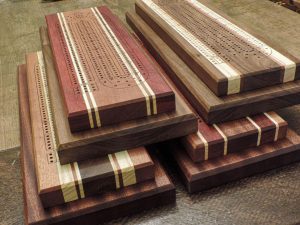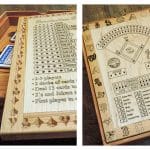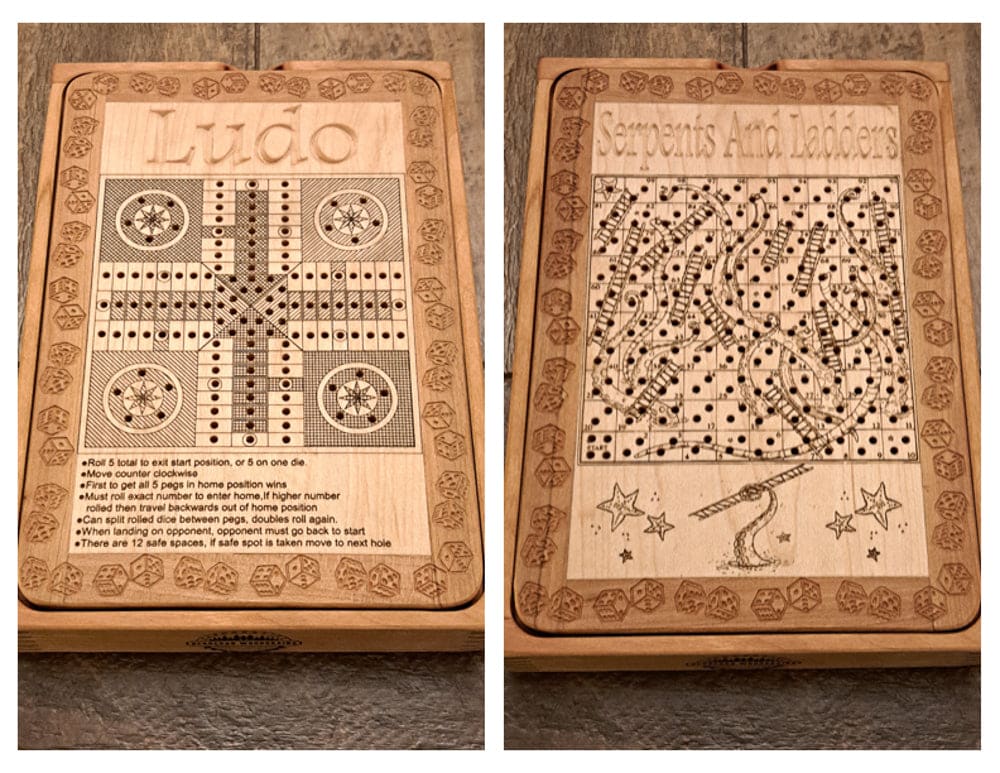Free Shipping On Orders Over $150 To Canada And US
Cribbage Rules
Cribbage Game Rules
Number of players
Two or 3 people may play. These cribbage rules describe two-player and 3-player cribbage.
Equipment needed
A cribbage board and a standard deck of 52 cards (jokers discarded).
Object of the game
The object of cribbage is to be the first player to score 121 points.
Two-player cribbage
Deal Six cards to each player and one to the crib. Each player then gives one card to the crib.
Three-player cribbage
Deal five cards to each player and one to the crib. Each player then gives one card to the crib.
Dealing and cutting
Cut the deck to determine who deals. Low card deals. Aces are low (one). For subsequent games, the loser deals.
The dealer deals 6 cards to each player.
The opponent puts two cards face-down into the dealer’s “crib”. The dealer also puts two cards face-down into the crib.
The opponent cuts the deck. The dealer takes one card off the deck at the cut point and places it face-up on the table. If this card is a jack, the dealer scores 2 points. This card will also be used later when scoring the hands.
Playing to 31
The opponent starts by playing one card face-up on the table. Players alternate turns. On their turn, each player announces the cumulative value of the cards played. An ace is worth 1, face cards are worth 10, all others are worth their face value.
When a player cannot play a card without the cumulative total exceeding 31, that player says “go” and passes their turn. The other player then continues to play all the cards they can without exceeding 31. When no more cards can be played, the count restarts at 0 and play continues. The player who said “go” plays the first card. Players can’t use cards played in the previous run to 31 for scoring combinations in this new counting round.
Points are scored in cribbage as follows:
Pair, three-of-a-kind, four-of-a-kind:
If a player follows another player’s card with a card of the same value, that player scores 2 points. They commonly say “a pair is 2”. If a player plays a third card of the same value (three-of-a-kind), they score 6 points. A fourth card (four-of-a-kind) scores 12.
Run:
A run (a straight) of 3 or more cards scores 1 point per card. The cards do not have to run in order. For example, if the cards are played 7-5-6, the player who played the 6 scores 3 points for the run. The other player could then lay down a 4, for example, and score 4 points for a four-card run.
15:
If a player plays a card that brings the cumulative total to 15 exactly, they score 2 points. Reaching 31 exactly also scores 2 points.
Go:
When a player passes (says “go”), the other player scores 1 point.
31:
The player who plays the final card, without reaching a total of 31, scores 1 point.
Clarification on scoring a go: If the player who scores the go then plays a card to reach 31, they score one point for the go but only one additional point for reaching 31.
Example:
The cards are played 8-7-7-6. The dealer played the 8. Then the opponent played the 7 and scored 2 points because the total is 15. Then the dealer played the second 7 and scored 2 points for the pair. Then the opponent played the 6 and scored nothing (this is not a run because of the extra, intervening 7).
Scoring the hands
Next, the players score the cards in their hand. They use the cut card as part of their hand. The opponent goes first and the dealer last. The dealer will score the value of the cards in their hand, then separately score the value of the cards in the crib also using the cut card.
Here is how points are scored for this round of play:
Pair:
A pair scores 2 points. Three-of-a-kind scores 6. Four-of-a-kind scores 12.
Run:
A run of three or more cards scores 1 point per card.
15:
A combination of two or more cards that add up to 15 exactly scores 2 points.
Flush:
A four card flush in the hand (not in the crib and not including the cut card) scores 4 points. A five card flush including the cut card, in the hand or crib, scores 5.
His Nobs:
A jack of the same suit as the cut card (which is called His Nobs) scores 1 point.
Players may use the same card more than once to make multiple scoring combinations.
Example:
The player has 7-7-7-8 and the cut card is a 9. The player scores 6 for three-of-a-kind. He can make 15 three ways (7 plus 8) so scores another 6 points. Also the player can make three runs of 7-8-9 for 9 points. The player’s total score for this hand is 21 points.
Winning the game
The winner is the first player to reach 121 points. If the loser fails to score at least 91 points, they are “skunked”. In match play, this is the equivalent of losing 2 games. If the player fails to score at least 61 points, they are “double-skunked”, which is the equivalent of losing 4 games. For scoring purposes, remember that the non-dealer counts their hand first. If they reach 121, the dealer can not count their points to try to avoid being skunked.





